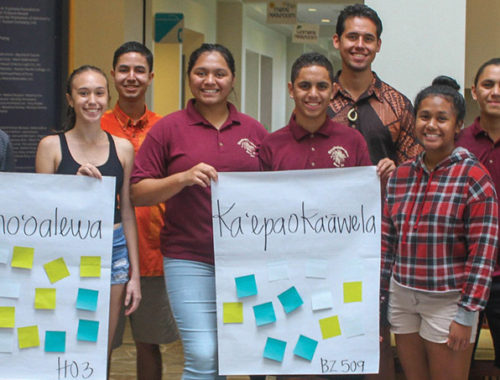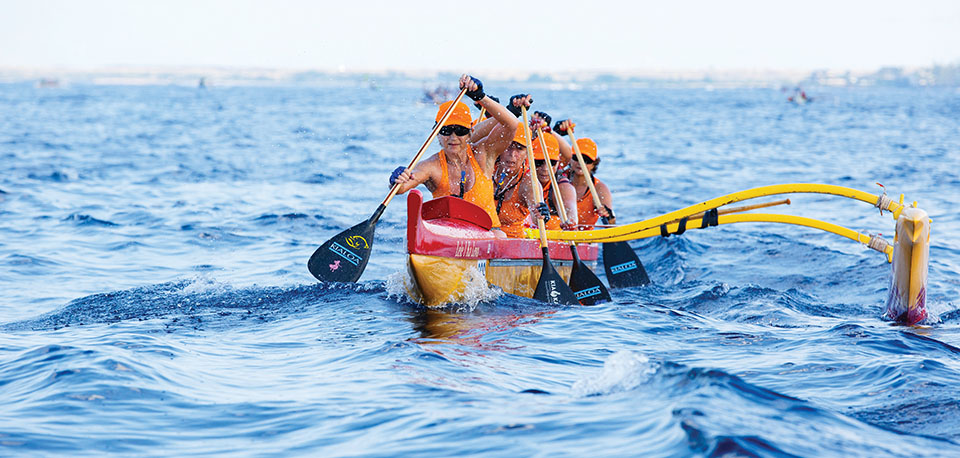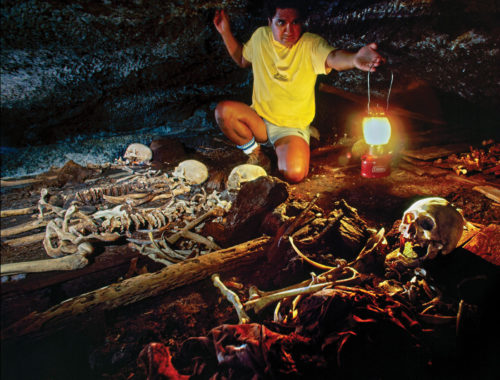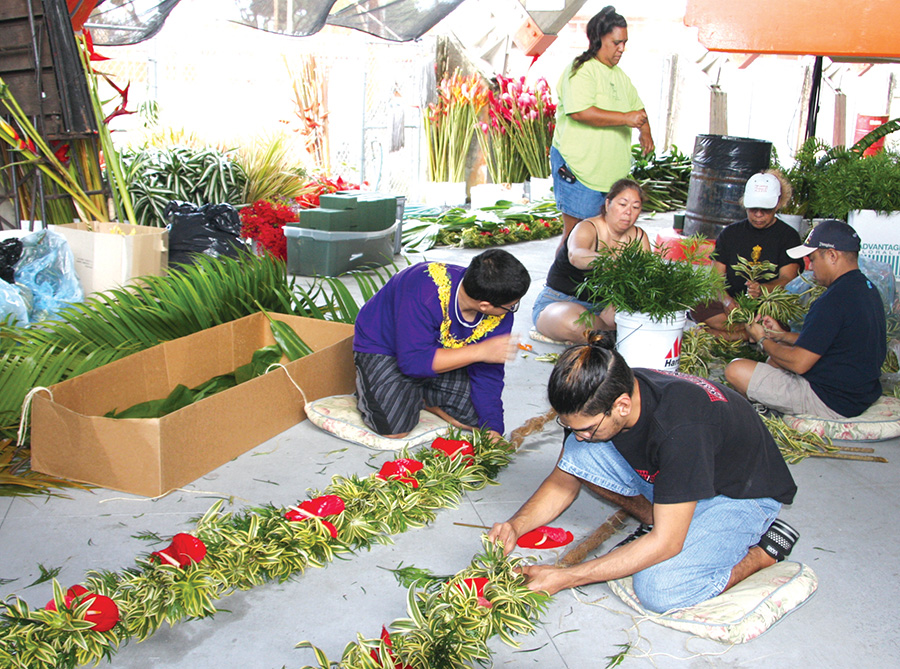
Behind the Scenes at the Merrie Monarch Festival
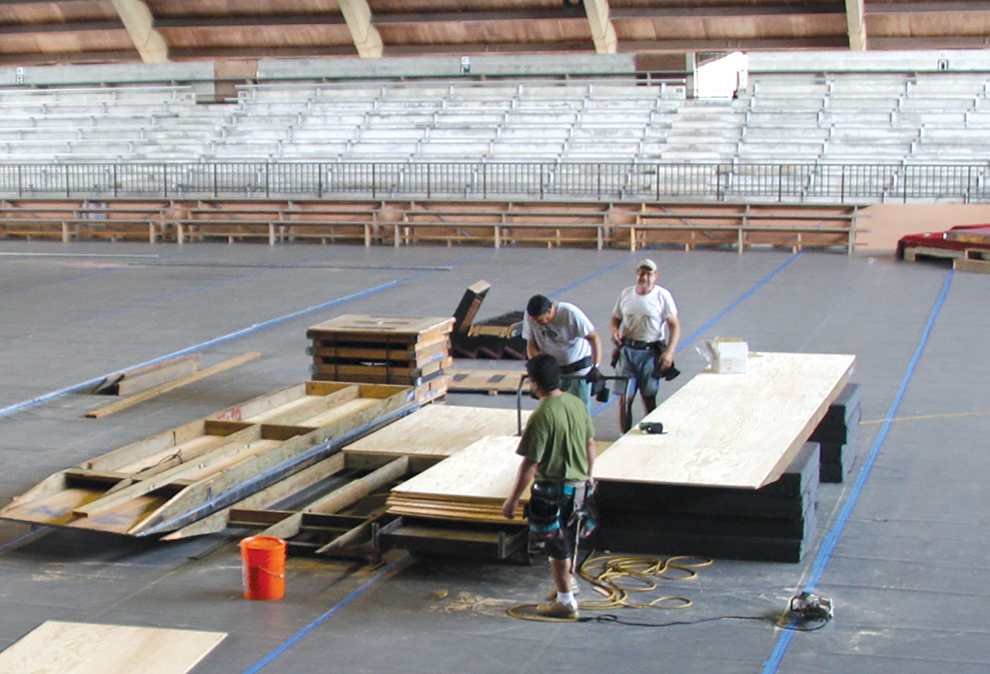
By Leilehua Yuen
A month before the opening kāhea (to call out) of the Merrie Monarch Hula Festival, the Edith Kanaka‘ole Stadium is filled with sound. Saws shriek, hammers pound, drills buzz, sanders growl, and the pine resin smell of lumber scents Hilo’s humid air. A stage grows in the stadium; a strong stage, one that hundreds of feet will move on. The dancers move slow and fast, soft and hard, pounding into it, turning in unison, changing direction over and over again, stressing the joists, posts, and plywood with compression loads, lateral loads, and dynamic loads the average floor would never hold. The people building it know what they are doing. They’ve done it before.
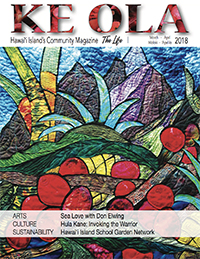
The stage construction crew is part of the team that works behind the scenes to make the Merrie Monarch Festival happen each year. Luana Kawelu, director of this annual celebration of “all things hula”, and daughter of the late “Aunty Dottie” Thompson, the previous director and a co-founder of the festival, estimates that more than two hundred people work together to make it happen.
What kinds of roles are there for 200 people in one festival? Aunty Luana says they include, “Ticket collectors, ushers, people setting up, cleaning and taking down chairs, civic clubs helping in booths, et cetera.” And that is just the week of the festival.
The rest of the year, a staff of eight volunteers work in the office, three of whom are there on a regular basis. “The others come in most of the days but are not here regularly. The week, or even a month before the festival, many more people, clubs, and organizations chip in to help,” Aunty Luana says. “Laulima,” literally “many hands,” is translated as a group of people working together. The Merrie Monarch Hula Festival is an example of laulima.
With the number of tasks to be done, and the number of people doing them, attention to detail is critical. For example, once the stage is built, it still has to be fine-sanded before dancers set foot on it. The dancers will be barefoot, and many hula steps are forceful, spinning and twisting swiftly. “The festival hires a contractor to put up the stage as well as take it down. It takes them five working days, including the fine sanding of the finished stage, to complete the job [of getting the stage built],” Aunty Luana says.
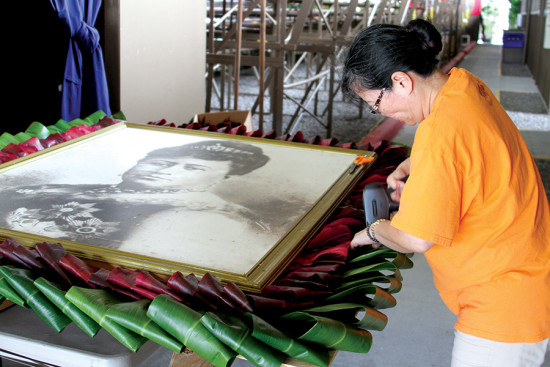
The stage has to be finished about a month before the festival so that hālau can start practicing. Entering and exiting on the ramps, ka‘i (entrance), hula (dance), and ho‘i (exit), all must be coordinated with the size and angles of the new stage so that everything flows, from the first footstep to the final bow.
About a week before the festival, the stage and dais for the Royal Court are decorated. King Kalākaua’s portrait is placed in a position of honor. Aunty Luana shares, “I see at least fifty or more people involved in the decorating of the stage. The hālau, as well as the parents and grandparents, are there to help. I leave the decorations completely up to the decorators.”
When the Merrie Monarch Festival added hula competition in 1971, Aunty Dottie’s co-founder, the late Uncle George Naope, tapped the haumāna (students) of his hālau to kōkua (help). As his haumāna became kumu in their own right, they, in turn, tapped their haumāna to help. For many hālau and haumāna hula, who were involved in the early days, returning to kōkua is a homecoming.

Now a third generation of hālau work with the festival. Kumu Ray Fonseca’s haumana, Kumu Hula Emery Aceret, is among those carrying on the tradition. Kumu Emery says, “The main theme of the Merrie Monarch Hula Festival is to honor the last king of Hawai‘i, King David Kalākaua. As far as the ‘yearly theme’—there really isn’t any. However, the Merrie Monarch Chair, Aunty Luana Kawelo, along with her committee, select a distinctive t-shirt design by a local artist, and a color to represent one of our eight Hawaiian Islands.”
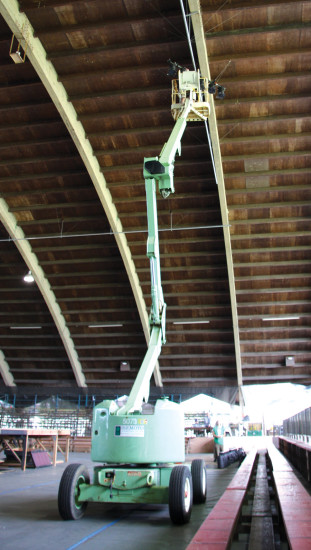
Once Aunty Luana selects a hālau, organization, group, or individual to do stage decorations, Kumu Emery says, “It is up to these groups to design and create an outstanding Hawaiian floral display.” The foliage is selected for durability as well as beauty. It will have to last through the festival with little maintenance. Kumu Emery continues, “Everything used has to be real. Decorating the Merrie Monarch stage takes place at least a week before the festival begins. When Aunty Dottie was still alive, she requested for the decorating deadline by midnight of Good Friday.”
The Hawaiian Islands are renowned for their lush foliage, and floriculture is one of Hawai‘i’s top diversified agriculture industries. Because Moku Hawai‘i (Hawai‘i Island) provides about half the flower inventory statewide, it is fitting that all of the Merrie Monarch foliage for the stage and dais comes from this island. Growers, nurseries, and farms donate everything. Kumu Emery says, “Most of the foliage is used in decorating the stage, from multicolored tī leaves, monstera, laua‘e, and palms, to anthurium, orchids, and birds of paradise. The surplus of the foliage and flora are then donated to various groups building floats for the Merrie Monarch Royal Parade, which happens on the last day of the festival.”
Aunty Luana says, “I think the world sees how rich and beautiful our hula culture is and that it is still ‘alive and well.’ It is a spiritual tradition that was almost lost but has been preserved and is still perpetuated by the many hands all working together.”
In addition to stage building and decorating, Kumu Emery also notes, “There are numerous people and groups that are involved. Here we are talking about the County of Hawai‘i, contractors, KFVE TV Station, private organizations/groups, nā hālau, schools, football teams, church and kūpuna (elder) groups. In addition, we have the inmates of our local prison putting in some community service time.”
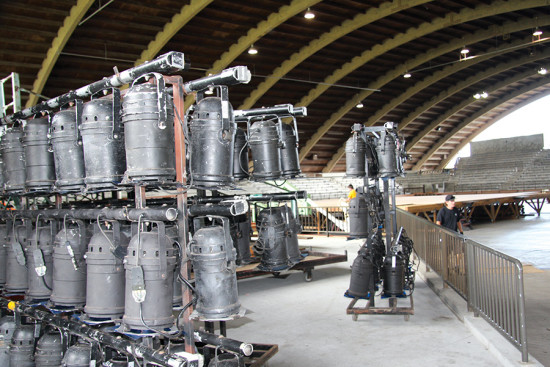
Another group that comes together to laulima for the Merrie Monarch Festival is Ke Kuini, the house band. Kelli Viernes, Ho‘o Apo and Kehau Tamure currently fill the roster. Aunty Luana says, “I am not sure how far back the house band goes but I can remember Kekua Fernandez and Ainsley Halemanu as part of the band.” All of the band members are experienced musicians who come together to kōkua the cultural showcase.
“The house band plays before and after the shows from Wednesday through Saturday,” Aunty Luana says. “So far, we have had the same band for many years. Some of the members in the band change but the core members usually stay. Sometimes the name of the band also changes.”
Playing music for hula is a skill in itself. The musicians provide an auditory platform for the dancer to work on, with a rock-steady beat, and clearly enunciated vocals. Hula is storytelling, and the story must be heard. The musicians must keep the focus on the dancer, eschewing the limelight for themselves.
Each of nā hālau have their own ho‘opa‘a (chanters and drummers) and musicians for the competition. Many are renowned artists and have their own fans, making listening, as well as watching, a delight. It is a small community, and bands may share musicians. At times it can seem like a bit of a round-robin as the musicians form and re-form bands in different configurations which will best serve the needs of the various hālau.

Between performances, a team sweeps the stage, making sure it is as pristine for the last hālau as for the first. Before the next night’s competition, decorators will check the foliage and flora, and make any necessary repairs or replacements.
The three competition nights fly by. Suddenly, it is Saturday night, and the last hālau has exited. During the score tally, the house band strikes up again. Nā kumu hula take the stage to share their aloha and dance the hula to which they have dedicated their lives.
Then the announcements are made, the prizes awarded, the hugs shared, and the tears shed. People spill out of the stadium and into the night. Ua lawa, ua pau. It’s enough, it’s done—almost.
Again, coordinated teamwork sweeps through the stadium, but in reverse. The foliage is bundled up and removed. The King’s portrait, the thrones, and all the accoutrements of royalty are removed. Squeals, shrieks, and thumps of tools resound through the stadium, along with the banging of lumber being stacked and chairs being folded. The cleanup crew begins sweeping as a month’s worth of work comes apart.

Kumu Emery shares, “Taking down the Merrie Monarch Stage is literally done overnight. Soon after the last award is given to the winning hālau, everything in the stadium is dismantled. It’s like nothing ever happened.”
Just like a hula, all of the training, practice, dress, and adornments come together for an ephemeral moment of beauty, remaining as he hali‘a aloha, a cherished memory. ❖
Photos courtesy of Kenji Kuroshima
For more information: merriemonarch.com
